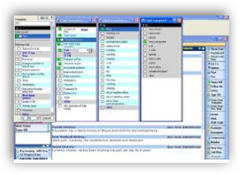The testimony today came from Ingenix, and they should know as they are the leaders of all the analytics, coding and algorithmic formulas out there, that less time  and attention is being paid to the user experience here. You know I think I can agree with that because that’s about all we hear in the news today about medical record systems is the aggregation for compliance and the quest to save money and there has not been much said in the area of the user experience. We certainly know that PHRs for patients are not catching on very quick, with the exception of closed systems like Kaiser who has maintained their original concept.
and attention is being paid to the user experience here. You know I think I can agree with that because that’s about all we hear in the news today about medical record systems is the aggregation for compliance and the quest to save money and there has not been much said in the area of the user experience. We certainly know that PHRs for patients are not catching on very quick, with the exception of closed systems like Kaiser who has maintained their original concept.
I also agree due to the fact that scribes are growing at a rapid rate that there must be something to this:) It’s a real irony when you want to bring doctors into the world of Health IT but the scribes which were supposed to be temporary jobs continue to thrive as full time assistants. I can only say for doctors who are on staff at more than one hospital with each one using different systems it must be a real joy at times, and keep in mind that upgrades and changes take place frequently with the software too, along with new rules and regulations from the hospitals. As you can see in the recent post below, one doctor thinks scribes are so great that nurses should have them too.
have them too.
Scribes Still Continue to Grow in Hospitals–One Doctor Stated He Could See the Trend Expanding To Help Nurses Too
The EHR systems today are much more complicated and intense than they were just 5 years ago and a lot of this is a good thing with new reporting and so on but let’s face it the screens need to be easy enough to use to enter and find information.
On the PHR side I still can’t get a peep out of the ONC, the Surgeon General or anyone in government talking about their personal experience with a PHR and this is the “social age” to where you would think if they want consumers to jump in here that they would consider being role models, but most of the time when I dig down into this topic I find a great majority of those who tell us we should be using a PHR, don’t bother themselves so we have a lot of the kettle calling the pot black when it comes to PHRs, in other words “Magpie Healthcare” that continues to thrive.
Needless to say electronic records are here to stay, in what and shape and form along with price is always up for discussion <grin>.
It’s a bear writing an EMR and getting it right too and I don’t think today we have the one on one relationship with the developers and the doctors that used to exist too, as we are so busy trying to figure out what to do with all the other data in other areas of our lives. This is an area that I feel is important not to miss, just based on what I did a few years ago as I thought I had a really neat new update and the doctors told me it sucked, so back to the drawing board to see what could be salvaged and usually work in some new requests from the doctors as there was always constant feed back and I liked that. Sure I had to get over myself on many occasions and was a bit disappointed as when things didn’t work it meant a whole lot more time on the keyboard but that’s the way the business works with a partnership between both and again I just don’t think we see that as much today.
The article goes on to further say that the distance we are seeing today with patients/doctors with the software is further than it’s ever been.  Applying for the stimulus money is not that difficult as it is set up but the changing Meaningful Use changes bring a lot of questions and uncertainties to the picture too, but we have technology throwing us that new left curve every day and that part is not going to change. We can, however, look a little differently too on how we interpret things as far as the program and design and that’s continuous also as it’s world we live in today.
Applying for the stimulus money is not that difficult as it is set up but the changing Meaningful Use changes bring a lot of questions and uncertainties to the picture too, but we have technology throwing us that new left curve every day and that part is not going to change. We can, however, look a little differently too on how we interpret things as far as the program and design and that’s continuous also as it’s world we live in today.
Come to think of it though, this is especially noticeable in Healthcare but it exists in other industries too with more interactions done via computer; however in healthcare with medical records we have very high standards. It’s kind of a shame though too as we go through all the time and effort with certifying medical records and do nothing for certifying payment algorithms for payers so the buck and red tap always stops there as the coding for diagnosis and treatments continues to get more complicated as well. BD
Small medical practices warned Congress on Thursday that health information technology risks being less than useless if it's designed to meet bureaucrats' arbitrary standards rather than the needs of doctors and patients.
Testifying at a House Small Business healthcare subcommittee hearing, the CEO of HIT Services company Ingenix said cost isn't the main reason physician's offices are struggling to make the switch to paperless. Rather, Andy Slavitt testified, the "purchase and design of technology (…) have taken a back burner to all of the compliance reporting requirements" needed to qualify for federal incentive payments.
"Today," Slavitt said in written testimony, "the end-users, doctors and patients, are further away than ever from system design, because new product development is focused on satisfying those regulatory hurdles, rather than on simple innovations that improve productivity."
Small practices give lawmakers an earful about DC-centric HIT regulations - The Hill's Healthwatch



0 comments :
Post a Comment